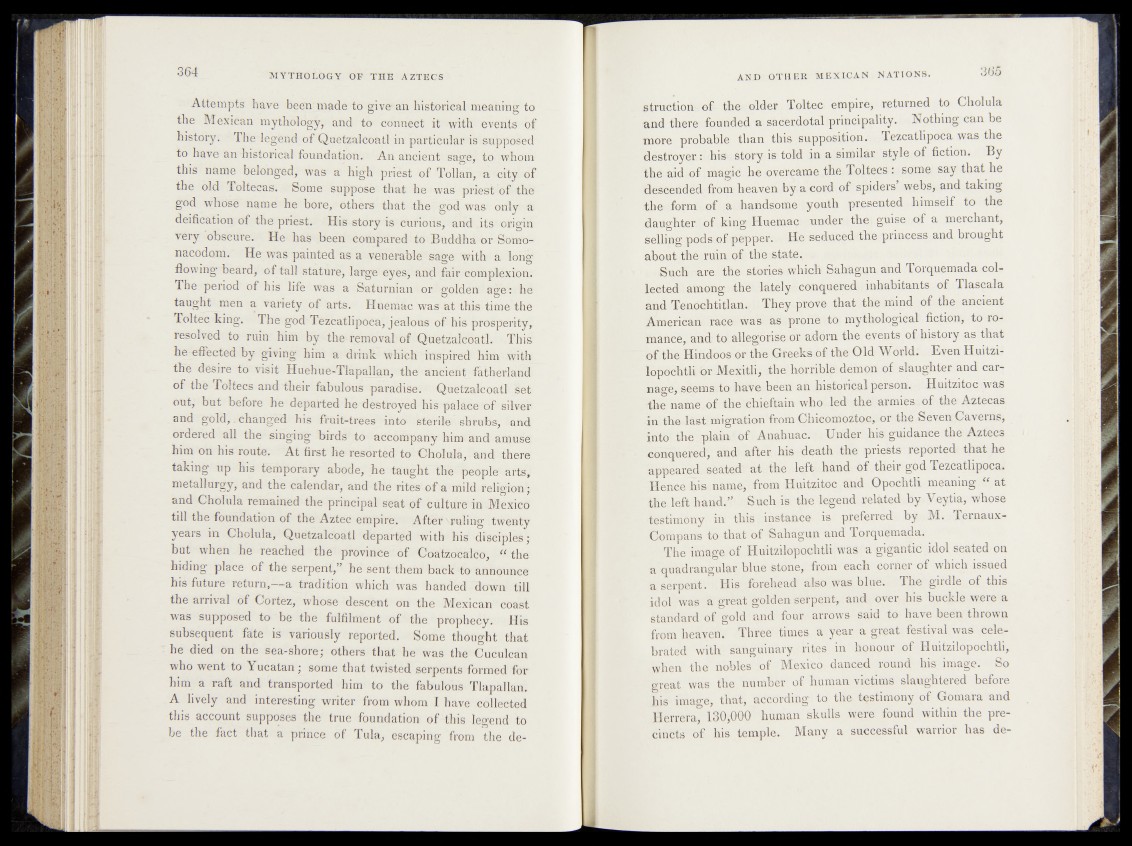
Attempts have bee’n made to give*an historical meaning to
the Mexican mythology, and to connect it with events of
history. The legènd of Quetzalcoatl in particular is supposed
to have an ‘historical foundation. An ancient sage, to whom
this name belonged, was a high priest of Tollan, a city of
the old Toltecas. Some suppose that he was; priest of the
god. whose name he bore, others that the^ god was only:' a
deification of the priest. His story is curious, and .its' origin
very obscure. He has been compared to Buddha or Somo-
nacodom. He was painted as a venerable sage with a long
flowing~beard, of tall stature, large’ eyes, and fair 'complexion.
The. period of his life was a "Saturnian or: golden age ;;'he
taught men a variety of arts. Hùémac wasmat this-time the
Toltec king. The god Tézcatlipoca, jealous of his prosperity,
resolved to ruin him by the removal of QuetzafeOatL ■ This"
he effected by giving him a drink Which inspired him with
the desire to visit Huehue-Tlapallan, the Efn&k^it fàthéri&kd!
of the Toltecs and their fabulous paradise. QuetzalcoaiMfeti
out, but before he departed heMestroyed hispalâ'cejp£jsi 1 veh
and gold,. changed his fruit-trees into -Sterile'shrubs, >-and
ordered all the singing birds* to accompany him.and • amuse
him on his route. At first he resorted to Choltda^and there
taking np his temporary abode, he taught the people arts,
metallurgy, and the calendar, and the rites' of a mild reigion ;
and Cholula remained the principal seat of culture in-MexieO
till the foundation of the'Aztec empire. After \ rnli lig : twenty
years m Cholula, Quetzalcpitl departed with his disciples)
but when he reached the province of Coatzocalco, t( the
hiding place of the serpent,” he sent them back to announce
his future return,——a tradition which was handed down till
the arrival of Cortez, whose descent on the Mexican coast
was supposed to be the fulfilment of the prophecy. His
subsequent fate is variously reported. Some thought that
he died On the sea-shore; others that he was the Cuculcan
who went to Yucatan; some that twisted serpents formed for
him a raft and transported him to the fabulous Tlapallan,
A lively and interesting writer from whom I have collected
this account supposes the true foundation of this legend to
be the fact that a prince of Tula, escaping from the de-
365
structiom ef- the older. Toltec empire, returned to Cholula
•and there founded a- sacerdotal principality. Nothing can be
more probable than this^supposition. Tézcatlipoca was the
destroyer.: his. story isktold in a similar style of fiction. By
the aid of magic he overcame the Toltecs : some say that he
descended from-heaven by a> cord of spiders webs, and taking
the-form of a (.handsome youth presented .himself to the
daughter', of king Huemdci .nndpmthet guise,»of a merchant,
[selling pödstof .pepper;_ He seduced the princess and brought
about the ruin of thestate. ||
. -Such are the stories which Sahagun and Torquemada collected
among*, the latelyconquered inhabitants of Tlascala
and Tenochtitlan. . They,prove that the pjflnd of the ancient
American- race was as prone to mythological fiction, to romance,
and to allegorise or. adorn the events of history as that
of the Hindoos or the Greeks of the Old World: Even Huitzi-
lopochtli or Mexitli, the horrible demon of slaughter and carnage,
seems to have been an historical person. Huitzitoc was
■the name of the chieftain who; led the armies ,of- the'Aztecas
in the last* migration from Chicomoztoe>,or the Seven Caverns,
into the plain of Anahuac. Under his guidance the Aztecs
conquered, and after his death the priests reported that he
appeared seated at the left- hand of their god Tézcatlipoca.
Henee his name, from Huitzitoc and Opochtli meaning “ at
the left hand/?M Such is the legend related.by Veytia, whose
testimony in this instance is preferred by M. Ternaux-
Compans to that of Sahagun and Torquemada.
The image, of Huitzilopochtli was a gigantic idol seated on
a quadrangular blue stone, from each corner of which issued
a serpent. His forehead also was blue. The girdle of this
idol was a great golden serpent, and over his buckle were a
standard of gold and four arrows said to have been thrown
from heaven. Three times a year a great festival was celebrated
with sanguinary rites in honour of II uitzilopochtli,
when the nobles of Mexico danced round his image. So
great was the number of human victims slaughtered before
his image, that, according to the testimony of Gomara and
Herrera, 130,000 human skulls were found within the precincts
of his temple. Many a successful warrior has de